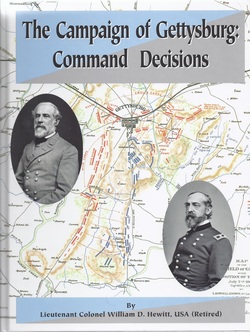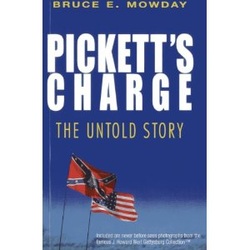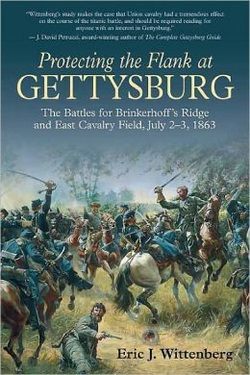
Lt. Col. William D. Hewitt (ret)
Thomas Publications – 296 pages
ISBN: 0578103028
Much has been written about the strategic and tactical shortcomings of the Gettysburg Campaign. William D. Hewitt attempts to do so in a different light and in a different layout than previous historians. With a lifetime of experience as a career military official, he uses his military experience to analyze the Gettysburg Campaign and comes up with something quite different.
Lieutenant Colonel William D. Hewitt is a seasonal guide at Gettysburg National Military Park and is retired from the United States Military with 31 years of experience in intelligence in armor and cavalry. He has edited many manuals of strategy and tactics along with analyzing battles which coincide with the armor and the cavalry.
Hewitt’s work, The Campaign of Gettysburg: Command Decisions, is an interesting book which chronicles the different parts of the battle. While most historians tend to think of battle as the first, second and third day of fighting, Hewitt takes a different approach by separating the major points of action as the pinpoints of the campaign. The complexity of the work is high and is more of a reference to a new thought of strategy than the common work on the battle or the campaign. Within the introduction of his work, he mentions that the book is not for “novices” and more for the experienced reader of the campaign. He does bring something new to the table when it comes to the analysis of the battle such as the leadership of the Union First Corps and the placement of the army between the days of combat. While he praises General Meade for his command abilities, he seems to disagree with the way in which the Union handles themselves during the battle. While he claims that Lee had no real leadership surrounding him at the battle, he analyzes more of the Confederate strategy of the battle instead of the Union. While this is understandable since the Union was mainly on the side of the defense, he devotes more time to analyzing the Confederate end of the field. He separates these analyses by chapters and does so with one chapter based on the Union side and another on the Confederate side. There is a feeling of want when it comes to his chapters based on the Union side of the conflict and he exhausts the Confederate side. This makes the book seem very one sided which good historians tend to avoid but cannot escape. The major failing of this book is the attitude in which Hewitt writes. He attempts to disprove previous historians by stating that everything which has come before him was false and this does not only appear once but many times. There is a wonder if he is ostracizing himself from the rest of the Civil War community by doing this in his own writing and what this could mean for his future scholarship. Hewitt also relies on the same sources, mainly Napoleon’s Maxims and Jomini, to analyze the situation instead of looking at the modern sources for the work which have done similar things to his own work.
In the end, what Hewitt’s work has accomplished is create a new type of study when it comes to the Battle of Gettysburg by breaking the combat up in phases instead of days. He is correct in stating that the more simple way of analyzing the battle is by days. This is the new thing which he brings to the study of Gettysburg but with a hope that there could be more study on the Union side of the battle.


 RSS Feed
RSS Feed
